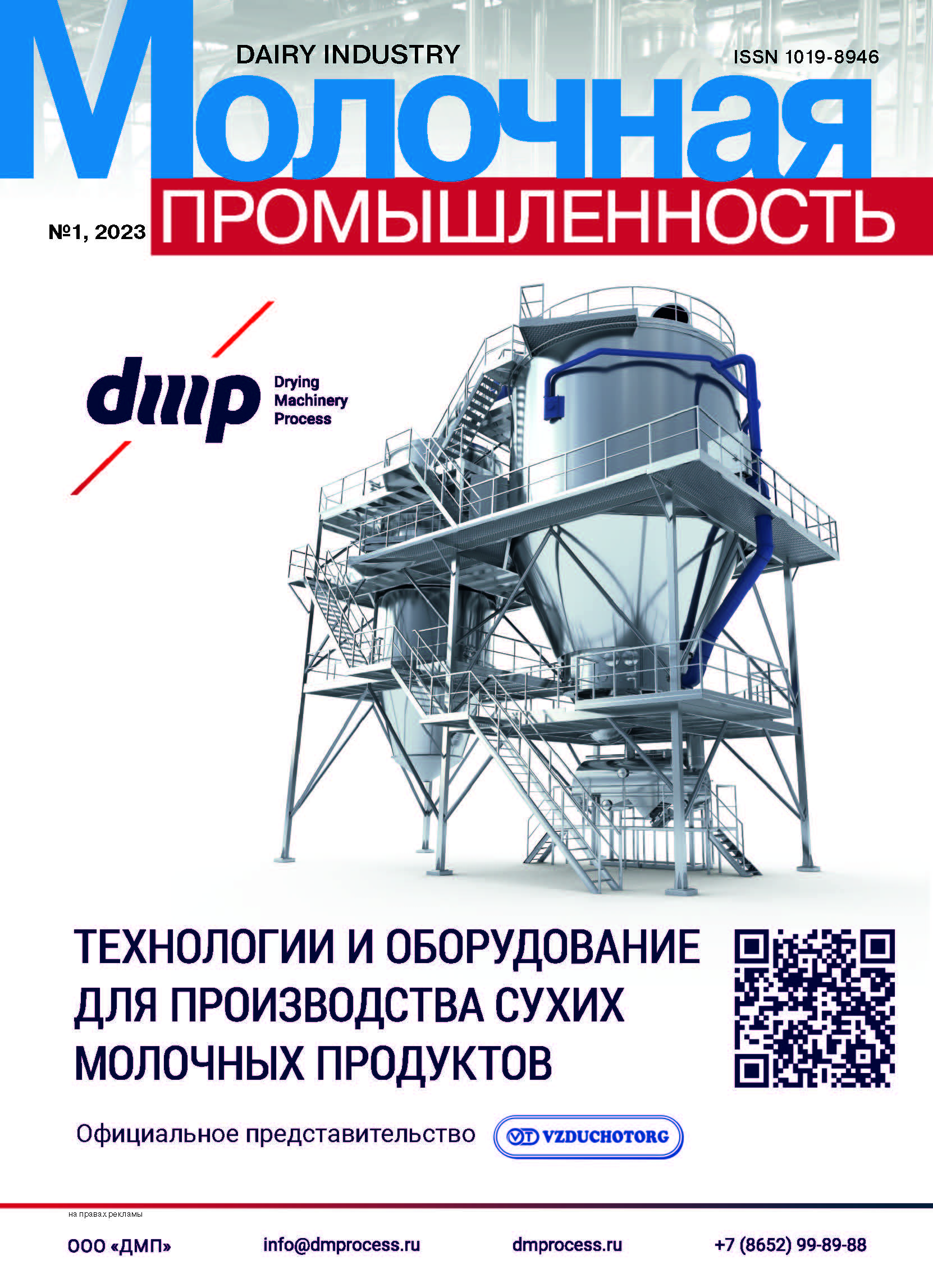Moscow, Russian Federation
Violation of production and storage regimes can cause contamination of milk and dairy products with spore microorganisms that produce toxins and cause foodborne illness. Of particular importance among such microorganisms is Bacillus cereus, which is the etiological agent of various types of food poisoning. In various types of food products, the joint vegetation of B. cereus with other opportunistic and pathogenic microorganisms is quite often recorded. The features of cultivation of potentially toxigenic strains of B. cereus isolated from milk and dairy products were studied, the tendencies and patterns of their joint vegetation with other microbial contaminants (S. aureus, Proteus spp. and E. coli), which increase the risk of toxic infections of mixed etiology, were determined. It has been established that with the simultaneous cultivation of S. aureus and B. cereus, a certain mutual synergistic effect is observed, accompanied by activation of the process of toxin formation by enterotoxigenic strains of S. aureus. A synergistic effect was observed both in the cultivation medium and in model products. The degree of this mutual influence is largely determined by the cultivation conditions, the composition of nutrient media, and the ratio of the initial levels of contaminants.
spore-forming microorganisms, food poisoning, Bacillus cereus, co-vegetation, toxin formation
1. Tirloni, E. Bacillus cereus in Dairy Products and Production Plants/ E.Tirloni [et al.]// Foods. 2022. V. 11. P. 2572. https://doi. org/10.3390/foods11172572
2. Ehling-Schulz, M. The Bacillus cereus Group: Bacillus Species with Pathogenic Potential/ M.Ehling-Schulz [et al.]// Microbiol. Spectr. 2019. V. 7. P. 1-35. DOI:/https://doi.org/10.1128/ microbiolspec.GPP3-0032-2018
3. Ehling-Schulz, M. Food-bacteria interplay: pathometabolism of emetic Bacillus cereus/ M.Ehling-Schulz, E.Frenzel, M.Gohar// Front. Microbiol. 2015. V. 6. P. 704. doi: 10.3389/ fmicb.2015.00704.
4. Jessberger, N. The Bacillus cereus food infection as multifactorial process/ N.Jessberger [et al.]// Toxins. 2020. V. 12. P. 701.
5. Tuipulotu, D.E. Bacillus cereus: Epidemiology, virulence factors, and host-pathogen interactions/ D.E.Tuipulotu [et al.] // Trends Microbiol. 2021. V. 29. P. 458-471.
6. Bekemeyer, W.B. Life-threating complications associated with Bacillus cereus pneumonia/ W.B.Bekemeyer, G.A.Zimmerman // The American review of respiratory disease. 1985. V. 131. № 3. P. 466-469.
7. Feng, M. Posttraumatic Bacillus cereus Endophthalmitis: Clinical Characteristics and Antibiotic Susceptibilities / M.Feng [et al.] // Journal of Ophthalmology Volume. 2021. Article ID 6634179. P. 1-6. https://doi.org/10.1155/2021/663417
8. Turnbull, P.C.B. Non-gastroentestinal Bacillus cereus infections: an analysis of exotoxin production by strains isolated over a two-year period/ P.C.B.Turnbull, S.M.Kramer // Journal of Clinical Pathology. 1983. V. 36. № 10. P. 1091-1096.
9. Fluer, F.S. Enterotoksiny Bacillus cereus/ F.S.Fluer// Zhurnal mikrobiologii, epidemiologii i immunobiologii. 2006. № 2. S. 105-110.
10. Pei, X. Prevalence of Bacillus cereus in powdered infant and powdered follow-up formula in China/ X.Pei [et al.] // Food Control. 2018. V. 93. P. 101-105.
11. Efimochkina, N.R. Mikrobiologiya pischevyh produktov i sovremennye metody detekcii patogenov/ N.R.Efimochkina. - M.: Izdatel'stvo RAMN, 2013. - 517 s.
12. Shinagawa, K. Serology and characterization of Bacillus cereus in relation to toxin production/ K.Shinagawa // Bulletin of the International Dairy Federation. 1993. V. 287. P. 42-49.
13. Schmidt, K. WHO Surveillance Programme for control of foodborne infections and intoxications in Europe. Sixth Report - FAO/WHO Collaborating Centre for Research and Training in Food Hygiene and Zoonosis, Berlin, 1995.
14. EFSA BIOHAZ Panel (EFSA Panel on Biological Hazards), 2016. Scientific opinion on the risks for public health related to the presence of Bacillus cereus and other Bacillus spp. including Bacillus thuringiensis in foodstuffs// EFSA Journal. 2016. V. 14(7). P. 4524. doihttps://doi.org/10.2903/j.efsa.2016.4524.
15. Spanu, C. Occurrence and behavior of Bacillus cereus in naturally contaminated ricotta salata cheese during refrigerated storage/ C.Spanu [et al.]// Food Microbiology. 2016. V. 58. P. 135-138.
16. Wang, P. Insight into Bacillus cereus Associated with Infant Foods in Beijing/ P.Wang [et al.]// Foods. 2022. V. 11. P. 719. ttps://doi.org/10.3390/ foods11050719.
17. Efimochkina, N.R. Sovershenstvovanie metodicheskih podhodov k konstruirovaniyu i ocenke kachestva suhih pitatel'nyh sred/ N.R.Efimochkina [i dr.]// Molochnaya promyshlennost'. 2006. № 3. C. 36-38.





